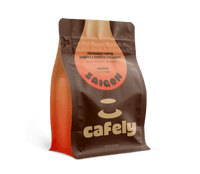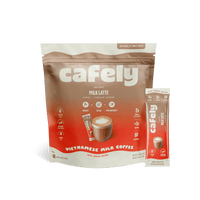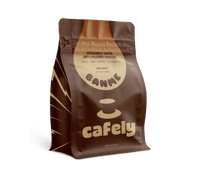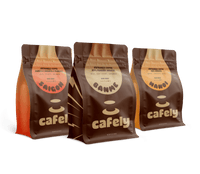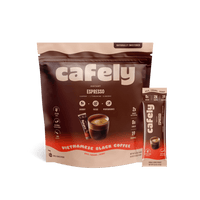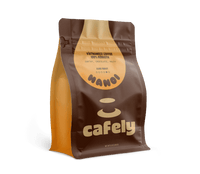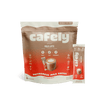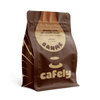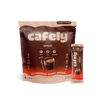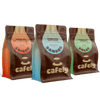Butter coffee exploded in popularity in the late 2000s after Dave Asprey, founder of Bulletproof Coffee, began promoting it as a high-energy, brain-boosting drink — however, this practice has been around for centuries.
There are two main types of butter coffee, depending on which stage the butter is added:
- Butter mixed with coffee (bulletproof coffee) — this process involves blending butter with a fresh cup of brewed coffee to provide a boost in energy and prolong the effects of caffeine over several hours.
- Butter-roasted coffee — this age-old practice has been used in places like Vietnam for generations to give the coffee a stronger flavor.
In this guide, we’ll explore the origins, benefits, and preparation methods for bulletproof coffee and butter-roast coffee.
1. Bulletproof Coffee (Coffee Mixed With Butter)

The practice of mixing butter with brewed coffee dates back several hundred years in cultures living in the Himalayas and East Africa.
The Himalayas is where Dave Asprey was first introduced to the idea — which has since gained widespread popularity.
In Tibet, a beverage called “Po Cha” — AKA “Butter Tea” — is made by mixing tea, yak butter, and salt. It was believed this beverage provided more energy than standard coffee or tea and provided additional calories to help meet the increased metabolic demands of the cold, high-altitude environment.
Today, bulletproof coffee is primarily used by followers of the ketogenic diet and those seeking its alleged energy-boosting capabilities. Some people mix butter; others use MCT oil (medium-chain triglyceride oil) instead for the same effect.
Butter Coffee Benefits
There are many health claims about the benefits of bulletproof coffee. Some of these claims are exaggerated, others are backed by solid research.
In general, advocates suggest the benefits of bulletproof coffee include:
- Increased mental & physical energy levels [3,5]
- Improvements in mental clarity, memory, & focus [1,2]
- Appetite suppression & increased resting metabolic rate [1,3,4]
- Ketosis support [5]
- Fewer side effects from caffeine (nausea, dizziness, anxiousness)
How to Prepare Bulletproof Coffee
Preparing bulletproof coffee doesn’t require any special ingredients or coffee.
Here’s what you’ll need:
- 1 cup of dark black coffee
- Grass-fed unsalted butter or ghee
- MCT Oil
Note: You can use MCT oil, butter, or a combination of both.
Here’s how to make it.
Step 1: Brew Your Coffee
You can brew your coffee any way you like, but the final yield should deliver around 1 cup (8 oz) of black coffee — so if you’re using a moka pot, AeroPress coffeemaker, or espresso machine, convert the final brew to an Americano by adding more hot water to dilute the coffee. If using a drip coffeemaker, just prepare a cup as normal.
You can also make excellent bulletproof coffee using a traditional Vietnamese phin filter, French press, standard drip coffee machine, vacuum pot (siphon brewer), or pour-over methods (such as Hario V60 or Chemex brewer).
Step 2: Mix in Your Butter or MCT Oil
For every 1 cup of coffee, you’ll want to mix about 2-3 tablespoons of butter or MCT oil. Some people even like mixing both — 2 tbsp of grass-fed butter and 1 tbsp of MCT oil.
Using a hand mixer or blender, mix the coffee until the fats have homogenized in the brew. You should have a nice creamy appearance with some froth at the top.
Step 3: Drink Up!
You should aim to drink your bulletproof coffee relatively quickly. Over time, the oils will start to separate from the coffee, leaving you with a thick, oily layer on the top and dark black coffee below. If you notice your coffee starting to separate, give it another vigorous stir with a spoon, which should get the oils to reintegrate.
Nutritional Profile of Bulletproof Coffee
Adding butter or MCT oil to coffee significantly alters the nutritional profile of the drink.
Here’s a comparison of regular black coffee versus the same volume of bulletproof coffee mixed with butter or MCT oil:
|
Regular Black Coffee (1 cup) |
Coffee with Butter (1 cup) |
Coffee with MCT Oil (1 cup) |
|
|
Recipe |
1 cup black arabica coffee |
1 cup black coffee mixed with 3 tbsp grass-fed butter |
1 cup black coffee mixed with 3 tbsp MCT oil |
|
Total Calories |
2.4 |
308.4 |
365.4 |
|
Total Fat |
0.1 g |
36 g |
39 g |
|
Saturated Fat |
0 g |
22 g |
33 g |
|
Trans Fat |
0 g |
1.4 g |
0 g |
|
Cholesterol |
0 mg |
93 mg |
0 mg |
|
Sodium |
4.7 mg |
273 mg |
0 mg |
|
Total Carbohydrates |
0 g |
0 g |
0 g |
|
Dietary Fiber |
0 g |
0 g |
0 g |
|
Sugars |
0 g |
0 g |
0 g |
|
Protein |
0.3 g |
0.7 g |
0.3 mg |
|
Caffeine |
90 mg |
90 mg |
90 mg |
2. Coffee Roasted With Butter

Some roasters add butter during the roasting process to give their coffee a stronger, more intense flavor.
The magic of coffee’s distinct taste comes down to the roasting process. When heated, the oils, sugars, and amino acids in the coffee bean fuse together to create new flavor compounds. These compounds provide the mouth-watering roasted flavor we know and love. This process is called the Maillard reaction (named after the man who discovered it).
Other roasted foods like chocolate, steak, bacon, and potatoes undergo the same process when roasted or cooked.
Butter-roasted coffee harmonizes with the dark, bold, and nutty flavors of Coffea robusta — which is the primary species grown in Vietnam and is considered a key ingredient in making Vietnamese coffee.
Buy Vietnamese butter roast coffee: SaiGon OG.
Why Roasting Makes Everything Taste Better
Many of the roasted, browned foods we know and love owe their delicious flavors to the Maillard reaction. It’s responsible for the distinct and delicious flavors of coffee, chocolate, toasted bread, and bacon.
This reaction is named after the French chemist Louis-Camille Maillard — who first described the reaction in 1912. It involves a chemical reaction catalyzed by intense heat that fuses amino acids to reducing sugars. High heat is necessary, which is why you’ll only find this reaction from processes that involve roasting, baking, frying, or grilling.
Coffee is already subject to the effects of the Maillard reaction as it undergoes the roasting process — but the addition of butter further enhances this effect.
Butter also contains milk solids that undergo a separate browning reaction while the coffee is roasting, adding a rich, nutty flavor as well as depth and complexity.
Where to Buy Butter Roasted Coffee
Butter is the secret ingredient in our best-selling coffee, SaiGon OG.
For this mix, we combine the best Vietnamese-grown arabica, robusta, and peaberry coffee we can find and roast them with butter using a technique that’s been passed down to us through generations.
Related: What Does Vietnamese Coffee Taste Like?
When to Avoid Butter-Roasted Coffee
Butter coffee is delicious. The intensity of its flavors stands out over conventional roasting methods.
There’s just one drawback.
The added oils in coffee beans roasted with butter can sometimes clog up expensive coffee grinders. As the beans are ground, some of the particles can stick to the sides or in the teeth of burr-style grinders.
This won’t damage the machine, but it can mean you’ll need to clean your device more frequently than with other beans. This could be especially problematic in espresso machines with integrated grinders. If the beans become clogged inside the internal grinding mechanisms, cleaning is much more difficult.
For espresso machines or coffee makers with built-in grinders, we recommend grinding butter-roasted coffees in a separate grinder — ideally, a blade-style grinder to limit the risk of clogging.
Alternatively, you can check out non-butter roasted versions of our coffees, such as our HaNoi (100% robusta), DaNang (50/50 robusta & arabica blend), or our DaLat (100% arabica coffee).
FAQs: Butter Coffee

1. What is bulletproof coffee?
Bulletproof coffee is a combination of regular black coffee and a source of fat such as butter or MCT oil. It was popularized by Dave Asprey and his brand “Bulletproof Coffee” and is consumed primarily for its purported energy-boosting and cognitive-enhancing effects.
2. How does bulletproof coffee differ from regular coffee?
Bulletproof coffee is different from regular black coffee in that it's high in fat. This is due to the addition of butter and/or MCT oil. This addition not only changes the calorie and fat content but also prolongs the absorption of caffeine to provide a more consistent and long-lasting effect.
3. Is there any scientific evidence supporting the benefits of bulletproof coffee?
Current research on the benefits of bulletproof coffee is limited and inconclusive. Most research has found minimal if any, statistically significant differences between regular black coffee and buttered coffee. There are some studies that show benefits in terms of satiety and energy expenditure, but the evidence is not strong. More specific research is needed to substantiate these claims.
4. Can butter coffee help with weight loss?
Some proponents of bulletproof coffee claim it can help with weight loss by decreasing hunger levels and boosting metabolism. Some studies support these claims, but others have shown little to no noticeable benefit. Bulletproof coffee may help some achieve their weight loss goals but should absolutely not be relied upon as a primary method for losing weight. In fact, the added caloric load of bulletproof coffee could even contribute to additional weight gain.
5. Is it safe to roast coffee with butter?
Yes, roasting coffee with butter is safe and has been a part of Vietnamese coffee culture for generations.
6. How do you make butter coffee?
To make butter coffee, brew one cup of coffee and blend it with 1-2 tablespoons of unsalted grass-fed butter and 1 tablespoon of MCT oil until the mixture is smooth and creamy. This process helps to emulsify the coffee and fat for a uniform texture.
7. Can butter coffee replace breakfast?
Buttered coffee (bulletproof coffee) can be used as a breakfast alternative due to its high level of calories and fats. However, it lacks essential nutrients and vitamins found in a balanced breakfast. This means it's necessary to ensure adequate nutrition throughout the rest of the day if butter coffee is used to replace traditional morning meals.
8. Are there any risks associated with drinking butter coffee?
The added butter in coffee brings with it an increase in saturated fats, cholesterol, and calories. This could be a concern for individuals with heart disease, those monitoring caloric intake, or anybody with dairy sensitivities.
MCT oil could be a viable alternative for those with dairy sensitivities but it delivers similar calories to butter.
References
- Crampton, K., Jackson, G., Streight, H., & Little, J. (2021). Investigating the Effects of a High-Fat Coffee Beverage Containing Medium-Chain Triglyceride Oil and Ghee on Cognitive Function and Measures of Satiety. Current Developments in Nutrition, 5, 902.
- Bergauer, A., Niekerken, L., Visser, T. F., Noa, K., Meng, A., & Varsamis, A. (2021). Bulletproof Coffee and Cognition. Maastricht Student Journal of Psychology and Neuroscience, 9(1), 37-58.
- Fritchen, J. (2016). Acute metabolic effects of Bulletproof Coffee (Doctoral dissertation).
- Baumeister, A.; Gardemann, J.; Fobker, M.; Spiegler, V.; Fischer, T. (2021). Short-Term Influence of Caffeine and Medium-Chain Triglycerides on Ketogenesis: A Controlled Double-Blind Intervention Study. J. Nutr. Metab. 1861567.
- Goldman, D. M., Lambert, K., Quarshie, M., & Craddock, J. C. (2023). Assessing the Validity of Bulletproof Coffee’s Claims. Beverages, 9(4), 101.
